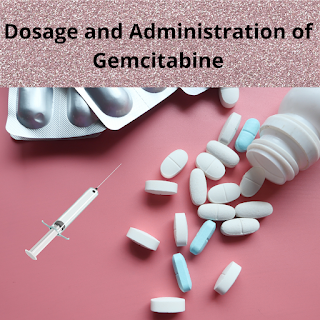Dosage and Administration of Gemcitabine
Gemcitabine is specifically a nucleoside analog and a chemotherapeutic agent. This agent was originally developed for its antiviral effects, but it is now recommended as an anticancer therapy to treat various cancers. The study of gemcitabine injection suggests that it is a cytidine analog with a couple of fluorine atoms replacing the hydroxyl on the ribose. As a prodrug, this drug is transformed into its active metabolites that act by replacing the building blocks of nucleic acids during DNA elongation, arresting tumor growth, and promoting apoptosis of malignant cells. The structure, metabolism, and working of gemcitabine are identical to cytarabine, but gemcitabine has a wider spectrum of antitumor activity.
Gemcitabine is available as the strength of
200 mg for intravenous administration. This drug is marketed as Gemzar.
Gemcitabine is approved by the FDA for the treatment of certain cancers which
are listed below. It is also being investigated in other cancer and tumor
types.
Non-Small
Cell Lung Cancer: The gemcitabine, alone or along with
cisplatin, is used for the first-line treatment of patients with locally
advanced or metastatic non-small cell lung cancer.
Pancreatic
Cancer: The gemcitabine is used for the treatment of
patients with locally advanced or metastatic adenocarcinoma of the pancreas.
Gemcitabine is used for patients with 5-FU refractory pancreatic cancer. The
respective patients treated with this medicine may derive improvement in
survival, significant clinical benefit, or both.
Bladder
Cancer: The gemcitabine 200mg is used for the treatment of patients with bladder cancer.
Breast
Cancer: The gemcitabine, together with paclitaxel, is
used for the first-line treatment of patients with unresectable, locally
recurrent, or metastatic breast cancer who have relapsed after adjuvant or
neoadjuvant chemotherapy, containing anthracycline, unless clinically
contraindicated.
Ovarian
Cancer: The gemcitabine, along with carboplatin, is
used to treat patients with recurrent epithelial ovarian carcinoma who have
relapsed after platinum-based therapy.
Dosage
and Method of Administration: The Gemcitabine 200 mg Injection is approved
for intravenous use only. This medicinal product contains no antimicrobial
agent or any kind of preservative. It is investigated for single use in single
patients only. Discard any residue.
NSCLC
(Single-agent Use): Adults:
The usual dosage of gemcitabine is 1000 mg/m2, should be given by 30-minute
intravenous infusion. This should be repeated once weekly for 3 weeks, followed
by a 1-week rest period. This 4-week cycle is then repeated. Reduction of dosage
with each cycle or within a cycle may be applied on behalf of the amount of
toxicity experienced by the patient.
NSCLC
(Combination Use): Adults: The Gemcitabine 200 mg injection along with
drug cisplatin is prescribed using 2 dosing regimens. The one dosing regimen
used a three-week schedule and the other used a four-week schedule.
The 3-week schedule used gemcitabine 1250
mg/m2, should be administered by 30-minute intravenous infusion, on Days 1'st
and 8'th of each 21-day cycle. Reduction of dosage with each cycle or within a
cycle may be applied on behalf of the amount of toxicity experienced by the
patient.
The 4-week schedule used gemcitabine 1000
mg/m2, should be administered by 30-minute intravenous infusion, on days 1'st,
8'th, and 15'th of each 28-day cycle. eduction of dosage with each cycle or
within a cycle may be applied on behalf of the amount of toxicity experienced
by the patient.
Pancreatic
Cancer: Adults: The recommended dose of gemcitabine is 1000
mg/m2, should be administered by 30-minute intravenous infusion. This needs to
be repeated once weekly for up to seven weeks followed by one week of rest. The
subsequent cycles need to be consist of injections once weekly for three
consecutive weeks out of every four weeks. The reduction of dosage with each
cycle or within a cycle may be applied on behalf of the amount of toxicity
experienced by the patient.
Bladder
Cancer: (Single-agent use): Adults: The recommended dosage of
gemcitabine is 1250 mg/m2, administered by a 30-minute intravenous infusion. The
dose should be given on Days 1'st, 8'th, and 15'th of each 28-day cycle. This
four-week cycle is then repeated. The reduction of dosage with each cycle or
within a cycle may be applied on behalf of the amount of toxicity experienced
by the patient.
Bladder
Cancer: (Combination use): Adults: The recommended dosage
for gemcitabine is 1000 mg/m2, which should be administered by a 30-minute infusion.
The dosage should be given on Days 1'st, 8'th, and 15'th of each 28-day cycle
along with cisplatin. Cisplatin is given at a recommended dose of 70 mg/m2 on Day
1'st following gemcitabine or Day 2'nd of each 28-day cycle. This four-week
cycle is then repeated. The reduction of dosage with each cycle or within a
cycle may be applied on behalf of the amount of toxicity experienced by the
patient. A clinical trial demonstrated more myelosuppression when the
medication named cisplatin was used in the doses of 100 mg/m2.
Breast
Cancer: (Combination Use): Adults: The gemcitabine injection
together with drug paclitaxel is prescribed using paclitaxel (175 mg/m2) given on
Day 1'st over around 3 hours as an intravenous infusion, followed by drug
gemcitabine (1250 mg/m2) as a 30-minute intravenous infusion on Days 1'st and
8'th of each 21-day cycle. The reduction of dosage with each cycle or within a
cycle may be applied on behalf of the amount of toxicity experienced by the
patient. The respective patients must have a granulocyte count for a minimum of 1500
(x 106/L) before initiating therapy with gemcitabine and paclitaxel
combination.
Ovarian
Cancer: (Combination use): Adults: The gemcitabine along
with carboplatin is recommended using gemcitabine 1000 mg/m2 given on Days 1'st
and 8'th of each 21-day cycle as a 30-minute intravenous infusion. After
medication gemcitabine, carboplatin should be administered on Day 1'st
consistent with a target AUC of 4.0 mg/mL/min. The reduction of dosage with
each cycle or within a cycle may be applied on behalf of the amount of toxicity
experienced by the patient.




Comments
Post a Comment